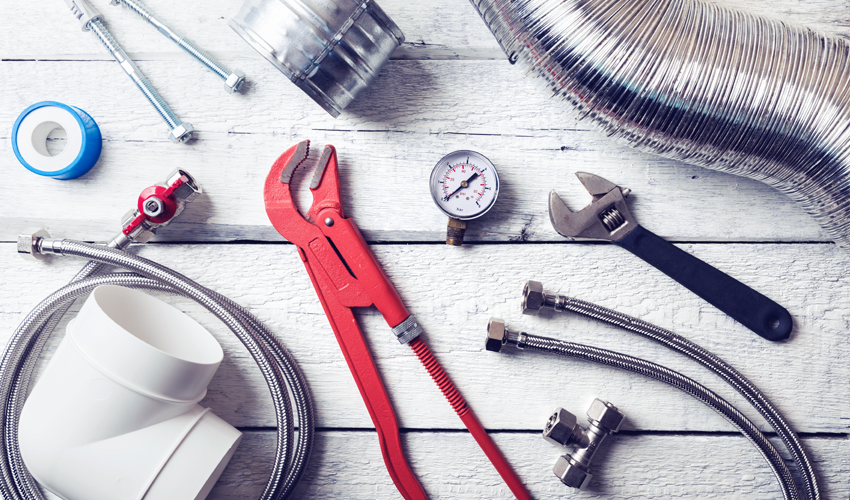
Aire Serv offers expert guidance on cleaning your AC unit’s drain tube to prevent clogs and water damage.
- Turn off the AC unit for safety.
- Locate and access the drain line.
- Use a wet/dry vacuum to clear blockages.
- Flush the line with distilled vinegar.
- Reassemble and restore power.
It can happen to anyone. You’re walking through your home, when suddenly – splat! Your feet splash into a gross, wet puddle on the floor. What happened? Unless your pet has a bladder control problem, it’s more than likely a clog in your AC unit’s drain line. Your AC doesn’t just cool your home, it also controls humidity, condensing moisture in the air and shuttling it outdoors through a small pipe called a drain line tube. Mucus-like algae, mold, mildew, and even ice in extreme temperatures, can build up inside your condensation drain line forming a clog that causes water to back up into lines, your AC unit, and eventually your home. If you need a flotation device to traverse your carpet, the AC condensate drain line is a likely culprit.
The AC drain line should be located near the outside unit, leading from your AC unit’s evaporator coil. It is typically a ¾-inch PVC pipe – however, some drain lines may be copper.
Feeling Brave Enough to Combat Your Own Clog?
- Locate your condensate drain line.
- Using a wet/dry vac you’ve previously removed the paper filter from, connect the attachment from the vacuum to the drain line using duct tape or simply wrap a cloth tightly around it with your hand.
- Run the wet/dry vac for a few seconds to a few minutes until the drain is clear.
Using Bleach in Your AC Drain
After the gunk has been removed from your drain line, get in the habit of performing a little DIY maintenance. Simply open up the drain line clean out or T on your inside unit and pour a 50/50 warm water and bleach mixture OR warm water and vinegar solution through the line. Be sure to use a minimum of 2 cups once or twice per year. Be advised, however, that some newer units no longer recommend bleach or vinegar due to oxidation/degradation concerns. In these cases, boiling water is recommended.
Preventing Future Clogs
If you don’t want to fork out tons of dough to repair water damage in your home, it would be a wise idea to perform a little maintenance on your AC drain lines.
- Keep your pitch. Drain lines should be properly angled down and kept clear of mud, grass, and debris for water to flow out properly.
- Flip the switch. Installing a safety switch to automatically turn off your AC whenever the drain line clogs can help you avoid expensive water damage.
- Schedule it out. Regular, professional maintenance not only keeps your system running at peak performance but can catch messy drain line clogs and other issues before they occur.
Contact Aire Serv Professionals for AC Cleaning
Call us today for 24/7 emergency service or schedule an appointment online.
This article is intended for general informational purposes only and may not be applicable to every situation. You are responsible for determining the proper course of action for your home and property. Aire Serv is not responsible for any damages that occur as a result of this blog content or your actions. For the most accurate guidance, contact the Aire Serv location nearest you for a comprehensive, on-site assessment.
FAQs About Cleaning an Air Conditioner Drain Line
As an industry leader and a brand that is trusted by homeowners and businesses nationwide for our knowledge and experience, we’re happy to answer your HVAC questions. Here are answers to some of the frequently asked questions about how to clean your AC drain line.
Can I use bleach to clean an AC drain line?
While some sources suggest using bleach in AC drain lines to prevent algae growth, exercise caution. Bleach can be corrosive to the metal components of your air conditioning system, particularly the aluminum evaporator coil, and can cause damage over time.
White vinegar is generally considered a safer alternative to bleach. However, some newer AC units explicitly advise against using bleach or vinegar due to potential oxidation or degradation. In such cases, hot water might be a safer option for flushing the drain line.
How often should you put bleach in an AC drain?
If you do use bleach, start with 2 cups of a 50/50 warm water mixture, and pour it in your drain line once or twice per year. However, pouring about a cup of white vinegar down the drain line every 1 to 3 months can effectively kill algae, mold, and mildew without the corrosive risks associated with bleach.
Is bleach safe to clean an AC drain line?
While bleach can effectively kill mold, mildew, and algae in your AC drain line, its use is debated due to potential risks. Bleach is corrosive to the metals commonly found in AC systems, particularly aluminum evaporator coils and even copper components. This corrosion can lead to leaks and system damage over time.
Safer alternatives include white vinegar, which is less corrosive, and hot water. Some newer AC models explicitly warn against using bleach or vinegar due to concerns about material degradation. Regular flushing with water or using a wet/dry vacuum to remove debris is often recommended as a preventative measure. Always consult your AC unit's manual for specific cleaning guidelines.
How to clean an AC drain line with bleach?
If you choose to use bleach for cleaning your HVAC drain line, follow these steps carefully:
- Turn off your AC unit to prevent any bleach solution from being drawn into the system.
- Locate the access point for the condensate drain line. This is usually a T-shaped vent or an open pipe near your indoor unit.
- Dilute the bleach. Never pour undiluted bleach into the drain line.
- Pour the diluted bleach solution slowly down the drain line access point, using a funnel if needed to avoid spills.
- Let it sit for about 30 minutes to allow the bleach to work on any mold, mildew, or algae buildup.
- Flush the drain line with plenty of clean water to remove any residual bleach. You can use a garden hose or pour water down the access point.
- Turn your AC unit back on and monitor for proper drainage.
How to unclog an AC drain line?
To unclog your A/C drain line, you should:
- Turn off the A/C unit.
- Locate the drain line. This is usually a PVC pipe near the outdoor condenser unit or the indoor air handler. There might be an access point or a T-shaped vent.
- Clear any visible blockage.
- Use a wet/dry vacuum :
- Remove the cap from the end of the drain line.
- Seal the vacuum hose tightly to the drain opening using duct tape if necessary.
- Turn on the vacuum to suction out any clogs or debris. You might see a significant amount of dirty water and gunk being removed.
- You can try pouring a bit of water down the indoor access point while vacuuming to help dislodge debris.
- Flush with vinegar or hot water:
- If vacuuming doesn't completely clear the clog, pour about one cup of distilled white vinegar down the drain line access point. Let it sit for about 30 minutes to break down any organic buildup. Flush with plenty of water afterward.
- Alternatively, you can try flushing the line with hot water.
- Use a drain snake (optional). For stubborn clogs, a small drain snake (plumber's snake) can be carefully inserted into the drain line to physically break up and remove blockages.
- Check the drain pan. Ensure the drain pan under your indoor unit is also clear of standing water and debris. You can use a wet/dry vacuum or rags to clean it.
- Pour water down the drain line to ensure flow.
- Replace the drain line cap.
- Turn on the AC and monitor drainage.
How to clean an AC drain line with vinegar?
Cleaning your HVAC drain line with vinegar is generally a safe and effective way to prevent clogs caused by algae, mold, and mildew. Here's a simple method:
- Turn off your AC unit.
- Locate the condensate drain line access point. This is usually a T-shaped vent or an open pipe near your indoor air handler.
- Pour about 1 cup of distilled white vinegar slowly down the drain line access point. You can use a funnel to avoid any spills. The vinegar will work to break down organic buildup.
- Let the vinegar sit in the drain line for about 30 minutes. This allows it sufficient time to effectively kill algae, mold, and mildew. For particularly stubborn buildup, you can let it sit for up to an hour.
- Flush the drain line with plenty of clean water. After the vinegar has had time to work, pour several cups of water down the access point to rinse away any remaining vinegar and dislodged debris.
- Turn your AC unit back on. Monitor the drain line to ensure water is draining properly. You should see water dripping from the end of the outdoor drain line.
How to flush an AC drain line?
To flush your AC drain line, first turn off the unit. Locate the access point near the indoor unit. Slowly pour hot water or about a cup of distilled white vinegar to kill buildup, let it sit for 30 minutes, then flush with several cups of water. Alternatively, use a wet/dry vacuum to suction out debris from the outdoor end. Regularly flushing helps prevent clogs.
How can I prevent AC drain line clogs?
Routine maintenance is key to preventing AC drain line clogs by addressing the root causes of blockages. Flushing the drain line with hot water, white vinegar, or a diluted bleach mixture inhibits the growth of algae, mold, and mildew, the primary culprits behind clogs.
Changing air filters frequently (every 1 to 3 months) reduces the amount of dust and debris entering the system, minimizing buildup in the drain line. Additionally, ensuring the condensate pan is clean and free of standing water prevents overflow that can contribute to clogs.
Annual professional inspections can identify and address potential issues before they escalate into blockages, ensuring proper drainage and preventing costly repairs. If blockages are a continual problem, consider indoor air quality solutions that can help keep your AC running smoothly.
Ready to experience fewer clogs and cleaner air? Learn more about the benefits of the Aire Serv Advantage Plan Membership for the routine maintenance your air conditioner needs.

